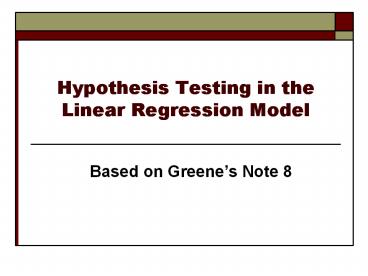Hypothesis Testing in the Linear Regression Model - PowerPoint PPT Presentation
1 / 16
Title:
Hypothesis Testing in the Linear Regression Model
Description:
We are interested in using the linear regression to establish or cast doubt on ... The model is used to test hypotheses about the underlying data generating process. ... – PowerPoint PPT presentation
Number of Views:579
Avg rating:3.0/5.0
Title: Hypothesis Testing in the Linear Regression Model
1
Hypothesis Testing in the Linear Regression Model
- Based on Greenes Note 8
2
Classical Hypothesis Testing
- We are interested in using the linear
regression to establish or cast doubt on the
validity of a theory about the real world
counterpart to our statistical model. The model
is used to test hypotheses about the underlying
data generating process.
3
Inference in the Linear Model
- Hypothesis testing
- Formulating hypotheses linear restrictions as a
general framework - Substantive restrictions What is a "testable
hypothesis?" - Nested vs. nonnested models
- Methodological issues
- Classical (likelihood based approach) Are the
data consistent with the hypothesis? - Bayesian approach How do the data affect our
prior odds? ? The posterior odds ratio.
4
Testing a Hypothesis About a Parameter
Confidence Interval
- bk the point estimate
- Std.Devbk sqrs2(XX)-1kk vk
- Assume normality of e for now
- bk Nßk,vk2 for the true ßk.
- (bk-ßk)/vk N0,1
- Consider a range of plausible values of ßk given
the point estimate bk. bk /- sampling error. - Measured in standard error units,
- (bk ßk)/ vk lt z
- Larger z ? greater probability (confidence)
- Given normality, e.g., z 1.96 ? 95,
z1.645?90 - Plausible range for ßk then is bk z vk
5
Estimating the Confidence Interval
- Assume normality of e for now
- bk Nßk,vk2 for the true ßk.
- (bk-ßk)/vk N0,1
- vk s2(XX)-1kk is not known because s2 must
be estimated. - Using s2 instead of s2, (bk-ßk)/est.(vk)
tn-K. - (Proof ratio of normal to sqr(chi-squared)/df is
pursued in your text.) - Use critical values from t distribution instead
of standard normal.
6
Testing a Hypothesis using a Confidence Interval
- Given the range of plausible values
- The confidence interval approach.
- Testing the hypothesis that a coefficient equals
zero or some other particular value - Is the hypothesized value in the confidence
interval? - Is the hypothesized value within the range of
plausible values
7
Wald Distance Measure
- Testing more generally about a single parameter.
- Sample estimate is bk
- Hypothesized value is ßk
- How far is ßk from bk? If too far, the
hypothesis is inconsistent with the sample
evidence. - Measure distance in standard error units
- t (bk - ßk)/Estimated vk.
- If t is large (larger than critical value),
reject the hypothesis.
8
The Wald Statistic
9
Robust Tests
- The Wald test generally will (when properly
constructed) be more robust to failures of the
narrow model assumptions than the t or F - Reason Based on robust variance estimators
and asymptotic results that hold in a wide range
of circumstances. - Analysis Later in the course after developing
asymptotics.
10
The General Linear Hypothesis H0 R? - q 0
- A unifying departure point Regardless of the
hypothesis, least squares is unbiased. - Two approaches
- (1) Is Rb - q close to 0? Basing the test on
the discrepancy vector m Rb - q. Using the - Wald criterion m?(Varm)-1m
- has a chi-squared distribution with J
degrees of freedom - But, Varm R?2(XX)-1R?.
- If we use our estimate of ?2, we get an
FJ,n-K, instead. - (Note, this is based on using e?e/(n-K) to
estimate ?2.) - (2) We know that imposing the restrictions leads
to a loss of fit. R2 must go down. Does it go
down a lot? (I.e., significantly?). - R2 unrestricted model, R2 restricted
model fit. - F (R2 - R2)/J / (1 - R2)/(n-K)
FJ,n-K. - These are the same in the linear model
11
t and F statistics
- An important relationship between t and F
- For a single restriction, m rb - q. The
variance is r(Varb)r - The distance measure is m / standard error of m.
- The t-ratio is the square root of the F ratio.
12
Lagrange Multiplier Statistics
- Specific to the classical model Recall the
Lagrange multipliers - ? R(X?X)-1R?-1m.
- Suppose we just test H0 ? 0, using the Wald
criterion. The resulting test statistic is just
JF where F is the F statistic above. This is to
be taken as a chi-squared statistic. (Note,
again, using e?e/(n-K) to estimate ?2. If e?e/n,
instead, the more formal, likelihood based
statistic results.)
13
Example
- Time series regression,
- LogG ?1 ?2logY ?3logPG
- ?4logPNC ?5logPUC ?6Year
? - Period 1953 - 2004. A significant event
occurs in October 1973. We will be interested to
know if the model 1953 to 1973 is the same as
from 1974 to 2004. Note that all coefficients in
the model are elasticities.
14
Example
- Simple Hypothesis
- Test about one ParameterH0 ?5 0
- Joint Hypotheses
- H0 ?4 ?5 0Using the Wald Statistic
- Chow Test Test for Structure Break
- Structural break at the end of 1973
- J Test
15
Algebra for the Chow Test
16
J Test
- Two Competitors
- Model XLogG ?1 ?2logY ?3logPG
?4logPNC ?5logPUC ?6Year ? - Model ZLogG ?1 ?2logY ?3logPG ?4logPN
?5logPD ?6PS ?7Year ? - Note, each has its own set of regressors. Can't
obtain either as a restriction on the other. - Strategy See if the fitted values from the
alternative model have any explanatory power in
the null model. If so, reject the null.































